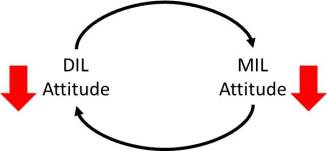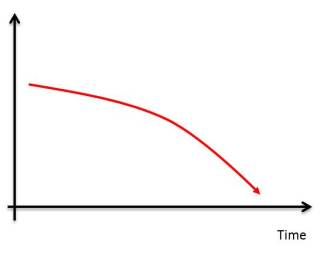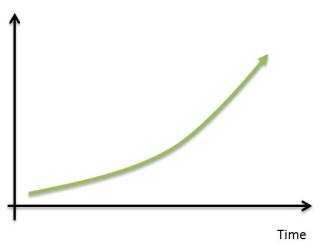As it appeared in the Sunday Standard, Botswana on Sunday Jan 20, 2013 edition.
Change Happens at the Speed of Thinking about the Whole Rather than of Our Parts
What causes the change to stay changed?
If we have managed change and it has happened, it should not go back to its old ways. Yes?
If it does, then, change, as the meaning of the word stands, really has not happened. And there is a reason. We have not yet understood how change happens.
Over the past two editions of this column, we ran a story of the mother-in-law and daughter-in-law and with the uncle’s help; we saw the relationship between the two turn from that which was sour and ugly to one where they have now became the best of friends.
Here’s a before and after summary of that story.
I left you with a question at the end of that story. How did the story help to bring about the changes in their situation?
Here’s a quick summary of the story:
As DIL began to smile at her MIL every night while she served her with a hot cup of milk, and MIL drank the milk it led MIL to feel more energized over time. As a result, things began to look up for the MIL who returns favour by cooking supper for her DIL. This leads to a chain of reactions that eventually sees the boss of the DIL praising her for a job well done with promises of a job promotion.
As things began to look up for DIL, she returns the favour to MIL by spring-cleaning the whole hose. When the MIL returns, she could not believe her eyes how all of their lives have transformed in a short four months and decides to call it truce between them. I left the story at the point MIL sitting down with DIL on the verandah enjoying their tea together.
How did a story that was going nowhere except horribly wrong (think crop or animal wipeouts, or budget deficits, or unemployment, or destitute not graduating or crimes not abating) turn around and as we speak enjoy a splendid outcome with all signs that anything from the past is now no more. How was that possible? What caused it?
Question is what caused the circle to stay turned around?
The Boiled Frog
Have you heard of the parable of the “boiled frog”? It is a metaphor that is very commonly used in Systems Thinking circles to understand how change happens in reality and to appreciate why corporates and nations die-off suddenly or what causes them to grow from strength-to-strength. In fact, we can’t appreciate systemic thinking without first appreciating this concept.

Many changes when they start, is not sudden or abrupt as many of us believe. They start very slowly and changes are often not perceptible on our radars and sometimes even dismissed off as one-off events. And yet, these small changes over time, often build themselves up eventually to crisis-level proportions.
It is a maladaptation on our part to recognize gradually building threats. Our minds and bodies are typically conditioned to see and react when a fire has become large. Not when it starts small.
How do we boil a frog? Yes, a frog! Not quite the ones we see around here. But the green slippery, wet species that live in water (not sand). Because if we attempted to catch them, they slip through our fingers. Literally. If we attempted to throw them in hot water, they jump off easily. So how then do we boil them (I did not ask, how do we eat them, smile).
Well, to boil them (like any change), it has start with where the frog is. They are cold-blooded animals and so when we place them in water, we place them in a cold pot of water. They sit there quietly. They are comfortable there. And then?
Well, then, we start with ONE piece of hot firewood. Place it under the pot. And since, it is only one piece; the water does not boil over suddenly. It boils gradually. So gradual that it allows the frog to adapt itself to the new temperature. It thinks to itself, “Haa … winter is over and spring has finally come.” But it sits in the pot. It does not jump out.
And then we bring on another piece of firewood. Again, the temperature in the pot rises gradually, but persistently. The frog has time to adapt again to its gradually changing surroundings. It even says to itself, “Summer is already here”. But it stays put in the pot.
And then, we bring on another piece of firewood. What do you think, the frog will say this time? You guessed it right! “Summer is really, really hot this times, is it not?” But it had time to adapt again. It is becoming groggy. But it stays put on the land, I mean, in the pot.
And when we bring on finally one more piece of firewood, well … the water is now boiling but the same frog that had first jumped out of the hot water when we first threw in it, continues to stay there. It does nothing. What has happened to it?
Well, it did not even know …. well, you know, died!
Why? Because the frog’s internal apparatus for sensing threats to survival is geared to sudden changes in his environment, not to slow, gradual changes. As a result, it did not react, and it got boiled.
Just as earth’s atmosphere when it warmed gradually over from the 70s nobody (on earth) thought much of it, because it was gradual and we adapted without being aware we were doing so. It was sub-conscious. While, we boiled (literally, sometimes), like the frog, the change too for the atmosphere, was boiling slowly, just like the frog in the parable.
For frogs to be boiled, the frogs must not know they are being boiled.
For change to happen, change must not know it is happening.
So, was the uncle, boiling “the frogs” between MIL and DIL? What was he boiling? Did you say their attitudes? Sure, you are right?
How did he do that? Remember, he was not even ‘at the scene of the crime’? How did he manage change, without managing (think performance management, coaching, mentoring, etc.) it?
There were ten things that happened in the story between MIL and DIL (refer to the story in the column’s edition dated Sunday Standard, Jan 13, 2013) that made the change possible. What were they?
This will make a great supper discussion with your own family, would it not? That will be the subject of discussion in Part V of this instalment.
Psst …. Are you still wondering what came of the liquid in the bottle? Well, the uncle admits later. It was not actually poison. It was Vitamin C. Yes! So the MIL is not only having a great relationship with her DIL, she is also now in the pink of health! Smile.
Wishing you a great week ahead of discovery and learning. Don’t forget the question? What were ten things that happened in the story between MIL and DIL that brought about a change in their lives?
Ms Sheila Damodaran, from Singapore and based here, is an international Strategy Development Consultant working with national planning commissions tasked with national strategy development. She welcomes comments at sheila@loatwork.com. For upcoming programmes, refer to www.loatwork.com/Senior_Leadership_Introduction.html.



